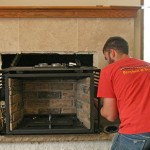Can You Spray Paint Inside of a Fireplace? A Comprehensive Guide
The prospect of spray painting the interior of a fireplace often arises when homeowners seek to refresh or modernize their living spaces. Fireplaces, while frequently focal points, can become stained, soot-covered, or simply outdated in appearance. Spray paint, known for its ease of application and relatively low cost, seems like a quick and convenient solution. However, the suitability of spray painting a fireplace interior is contingent on several crucial factors, including the type of fireplace, the paint used, and the preparation undertaken. This article will provide a detailed examination of these factors, outlining the potential risks, necessary precautions, and alternative approaches.
The primary concern when considering spray paint for a fireplace is safety. Fireplaces are designed to withstand high temperatures, but not all paints are created equal in this regard. Using the wrong type of paint can lead to hazardous fumes, paint degradation, and even fire. Furthermore, the porous nature of materials commonly used in fireplace construction, such as brick and stone, can affect paint adhesion and durability, requiring meticulous surface preparation.
Understanding Fireplace Types and Their Materials
Before considering any painting project, it is imperative to identify the type of fireplace under consideration. Fireplaces can broadly be categorized as wood-burning, gas, or electric. Wood-burning fireplaces generate the highest temperatures and produce soot and creosote. Gas fireplaces, while cleaner-burning, still generate significant heat, and electric fireplaces primarily produce heat through electrical resistance, often with a simulated flame effect. The materials used in fireplace construction also vary widely. Common materials include brick, stone, concrete, metal, and manufactured stone veneers. Each material possesses unique properties that affect its interaction with paint.
Brick, for instance, is porous and absorbent, requiring a primer to ensure proper paint adhesion and prevent the paint from being absorbed into the brick. Stone can have varying textures and densities, necessitating different preparation techniques. Metal surfaces, often found in fireplace surrounds and fireboxes, require specific primers and paints designed to withstand high temperatures and prevent rust. Understanding the materials present in a fireplace is crucial for selecting the appropriate paint and preparation methods.
The firebox itself, which is the interior space where the fire actually burns, presents the greatest challenge. High temperatures and direct exposure to flames demand specialized high-heat-resistant paints specifically formulated for this purpose. Standard paints will quickly degrade, blister, and release noxious fumes. Different components of the fireplace, such as the surround or mantel, may be constructed of different materials and can be addressed differently than the firebox.
Selecting the Right Paint and Primer
The selection of paint is the most critical step in determining whether it is suitable to spray paint a fireplace. Regular household paints are not equipped to handle the extreme heat conditions inside a fireplace. Therefore, only high-heat-resistant paints, specifically designed for fireplaces, stoves, and other high-temperature applications, should be considered. These paints are formulated with resins and pigments that can withstand temperatures ranging from 600°F to 1200°F or higher.
When choosing a high-heat-resistant paint, it is essential to carefully read the product label and ensure that it is appropriate for the intended application. The label should specify the maximum temperature rating, the recommended surface materials, and any specific preparation instructions. It is equally important to select the correct primer, which plays a critical role in promoting paint adhesion and preventing rust or corrosion. A high-heat-resistant primer, compatible with the chosen paint, should be used on all surfaces to be painted. Some high-heat paints are self-priming but reading the manufacturer's instructions is a must.
For metal surfaces, high-heat-resistant enamel paints are often the best choice, providing a durable and corrosion-resistant finish. For brick or stone, specialized masonry paints or coatings designed for high-temperature applications should be used. Consider also whether a matte, satin, or gloss finish is desired, as this can affect the overall aesthetic of the fireplace. The color selection may be more limited with high-heat paints compared to standard paints.
Furthermore, it is important to consider the volatile organic compounds (VOCs) content of the paint. VOCs are emitted as the paint dries and can be harmful to human health. Low-VOC or zero-VOC paints are preferable, especially when painting in enclosed spaces. Ensure adequate ventilation during and after the painting process, regardless of the VOC content.
Preparation, Application, and Safety Precautions
Proper preparation is essential for achieving a successful and durable paint job inside a fireplace. This process begins with a thorough cleaning of the fireplace interior. Remove all loose debris, soot, and ash using a wire brush, vacuum cleaner, and damp cloth. For stubborn stains, a mild detergent or degreaser can be used, followed by a thorough rinsing with clean water. Allow the fireplace to dry completely before proceeding. Repair any cracks or damaged areas with a suitable masonry patching compound.
Next, mask off any areas that should not be painted, such as the fireplace surround, mantel, or hearth. Use painter's tape and plastic sheeting or drop cloths to protect these surfaces from overspray. Ensure that the masking is secure and covers all exposed areas completely.
Before applying the paint, prime the surface with a high-heat-resistant primer, following the manufacturer's instructions. Apply the primer in thin, even coats, allowing it to dry completely between coats. This will promote paint adhesion and prevent the paint from peeling or blistering. Shake the spray paint can thoroughly before use, and hold the can approximately 10-12 inches from the surface. Apply the paint in thin, even strokes, overlapping each stroke slightly to ensure complete coverage. Avoid applying too much paint in a single coat, as this can lead to drips and runs. Allow the paint to dry completely between coats, as specified by the manufacturer.
Safety is paramount during the painting process. Always wear appropriate personal protective equipment (PPE), including a respirator or face mask, safety glasses, and gloves. Work in a well-ventilated area, opening windows and doors to allow for adequate airflow. Avoid spraying near open flames or heat sources. Store paint cans in a cool, dry place, away from heat and sunlight. Dispose of used paint cans and rags properly, following local regulations.
After the paint has dried completely, remove the masking tape and plastic sheeting carefully. Inspect the painted surface for any imperfections, and touch up as needed. Allow the paint to cure completely before using the fireplace. Refer to the paint manufacturer's instructions for the recommended curing time.
It’s also vital to understand that even with proper preparation and high-heat paint, the painted surface of the firebox isn’t completely immune to wear and tear. The high temperatures and abrasive nature of burning wood can eventually cause the paint to fade, chip, or blister, requiring periodic touch-ups or re-painting.

How To Paint The Inside Of A Fireplace Simple Upgrade Maria Louise Design

How To Spray Paint Fireplace Interior The Diy Playbook

How To Paint The Inside Of A Fireplace Simple Upgrade Maria Louise Design

How To Paint The Inside Of A Fireplace Simple Upgrade Maria Louise Design

How To Spray Paint Fireplace Interior The Diy Playbook

How To Paint The Inside Of A Fireplace Simple Upgrade Maria Louise Design

How To Paint Inside A Fireplace An Updated Look Painting

Fireplace Makeover Spray Paint Magic

How To Spray Paint A Brass Fireplace Insert Erfly House

How To Spray Paint Fireplace Interior The Diy Playbook
Related Posts








